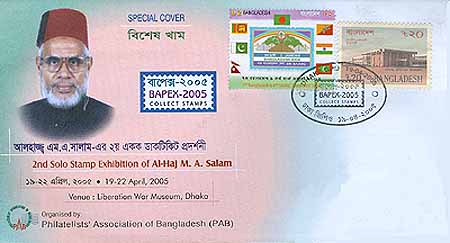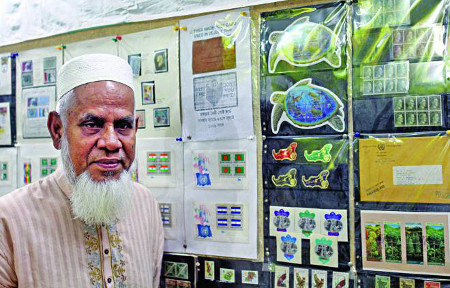Initially, I began to collect the stamps and covers of Bangladesh back in the mid- 1970s. It was a period when dealers offered both the overprinted stamps of Pakistan and the new Bangladesh stamps equally. Everyone was trying to make sense of the offerings as there was no philatelic information readily available to anyone outside Bangladesh and no one was publishing reliable information in the philatelic press.
About a year later, I found that every overprinted stamp I had purchased, plus the Boy Scout and Moukti Fouz covers, were either fakes or forgeries, largely fakes. The few stamps and souvenir sheets of Bangladesh that I had were put in a stock book and not looked at again until the 1990s. At that time, I began to see offerings for Bangladesh stamps on the internet, including imperforate stamps, errors, FDCs, etc.. This sparked my interest again and I found my meager collection of Bangladesh stamps and fake covers and made a few purchases. Eventually, I came to view my collection of fakes and forgeries as a “reference collection”.
My biggest frustration is finding scarce Bangladesh stamps placed on envelopes and generally sent registered mail to the same person, a friend, or a relative. These “philatelic covers” hold little value and interest in the West and I wish the practice would stop as the stamps in question are much more valuable as mint stamps.
Since I am a chronic list maker, I had lists of stamps and covers I owned, lists of items offered to me, and lists of items seen on the internet. The majority of the material was not listed in any catalog and it was the only way I could keep track of what existed. It is rather ironic that I would write this catalog as I have never been to Bangladesh, do not speak Bangla, have never seen another collector’s Bangladesh collection, nor have I ever personally met another collector of Bangladesh, other than the Salams.
Through the internet I made contact with Mohammad Hasnat and Muzammel Haq, both living in the State of New York at the time. With their help I began to add interesting items to my collection and learned a great deal more information about the material.
The big breakthrough came when I made contact with Mosharaf Husain in Dhaka. He was tireless in finding items for me and sharing information. Most of the foundation of my collection is due to his efforts.
When I began to illustrate some of the material on my web site, collectors in Bangladesh began to contact me and thanked me for posting the material. Some of them became good friends over the years. Faisal Rahman, Ataul Quadir and Mannon Mashur Zarif have been very important in the assembling of the information presented here in the catalog. They were constantly answering my questions and finding specific items for me I had heard about and wanted. Also, Obaidul Hassan, in Bangladesh, has generously permitted me to illustrate errors in the catalog from his collection that were previously not recorded. Through the generous efforts of Mushfiqul Haque and Sajid Rahman I have been able to add new information to the catalog.
I would also like to mention the generosity of Dr. Ataul Quadir who has been tireless in offering and obtaining items for me over the years. It would not have been possible for me to assemble all the rarities in my collection without his help. He was also incredibly helpful in obtaining and explaining all the show material from 2009 – 2013.
I would like to mention Mr. Zahid Husain (Helal Bhai) who spent years of his life looking for, and selling, the majority of the major errors of the country. Without his contacts and keen eye, it is possible they might not have become known to collectors. While he is known to all the dealers, most of the general stamp collectors know nothing about him. While he should be thanked for these efforts, there is another side to the coin. He is also responsible for many fakes coming to the market that he either made, or “commissioned” to be made, such as the Rotary overprints of 1987, all the Russian printed definitives and other definitives, with the “SERVICE” overprint that flooded the market in about 1999, fake FDCs of the first sets of definitives and more recently (2014) the Upa-Zila Election overprints of 1985.
All of the Bangladeshis told me there were many collectors of Bangladesh stamps in Germany and were surprised I did not know them. Eventually, I made contact with Werner Gras who was very generous in sharing information. Since my German is almost non-existent, and the same for his English, we had a hard time communicating but that did not stop the exchange of information. I might add that I have all of the printed scans he sent to me in a notebook for reference.
The name M. A. Salam kept cropping up in emails and even appeared on a cover I owned. By coincidence, I purchased something on the internet and the person selling it was Shaheen Salam, the son of M.A. Salam. It turned out he lives in Illinois and when his father came to visit, arranged a meeting at my home. Since then, I have met with Mr. Salam several times while he was visiting. I have also visited Shaheen and his family in their home several times.
Mr. Salam was always able to answer all of the questions I had and even related his personal involvement in some of the situations I had questioned. Over the years he offered me many scarce and unusual items.


R. Howard Courtney
Chicago, IL
20 October 2022



